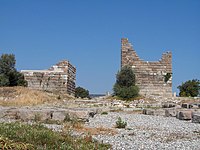
Back حصار هاليكارناسوس Arabic هالیکارناس موحاصیرهسی AZB Обсада на Халикарнас Bulgarian Belagerung von Halikarnassos German Πολιορκία της Αλικαρνασσού Greek Sitio de Halicarnaso Spanish محاصره هالیکارناس Persian Halikarnassoksen piiritys Finnish Siège d'Halicarnasse French המצור על הליקרנסוס HE
| Siege of Halicarnassus | |||||||||
|---|---|---|---|---|---|---|---|---|---|
| Part of the Wars of Alexander the Great | |||||||||
 The siege and capture of Halicarnassus under Alexander the Great | |||||||||
| |||||||||
| Belligerents | |||||||||
|
Hellenic League |
| ||||||||
| Commanders and leaders | |||||||||
|
Alexander the Great Hephaestion |
Orontobates Memnon of Rhodes | ||||||||
| Casualties and losses | |||||||||
| Much greater loss of men and money than the Persians. | Unknown | ||||||||
Location of the siege of Halicarnassus | |||||||||
The siege of Halicarnassus was fought between Alexander the Great and the Achaemenid Persian Empire in 334 BC. Alexander, who had no navy, was constantly being threatened by the Persian navy. It continuously attempted to provoke an engagement with Alexander, who would not oblige them. Eventually, the Persian fleet sailed to Halicarnassus, in order to establish a new defense. Ada of Caria, the former queen of Halicarnassus, had been driven from her throne by her younger brother Pixodarus of Caria. When Pixodarus died, Persian King Darius had appointed Orontobates satrap of Caria, which included Halicarnassus in its jurisdiction. On the arrival of Alexander in 334 BC, Ada, who was in possession of the fortress of Alinda, surrendered the fortress to him.[2]
It seems that while our Greek sources describe the capture of the settlements of Halicarnassus as a Macedonian victory, they completely ignore that Alexander's thoughts were not in this direction. Because the result of the conflict was very heavy, and there was a much greater loss of people and money than the enemy. Since the Macedonians lost their superiority, it was impossible to even consider this as a victory despite great losses. Therefore, our sources could also describe the Siege of Halicarnassus as a direct Macedonian defeat.[3]
-
Map of Halicarnassus at the time of the siege
-
Ruins of the fortications around Halicarnassus (the Myndus Gate), 4th century BC
- ^ Lenderıng, Jona. Büyük İskender. Kronik. p. 104. ISBN 9789752430396.
- ^ Cartledge, Paul (2004). Alexander the Great the hunt for a new past. Overlook Press. ISBN 1-4050-3292-8. Retrieved 2 July 2024.
- ^ Lenderıng, Jona. Büyük İskender. Kronik. p. 105. ISBN 9789752430396.



